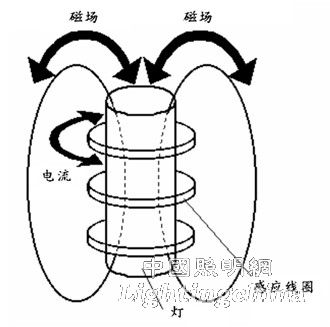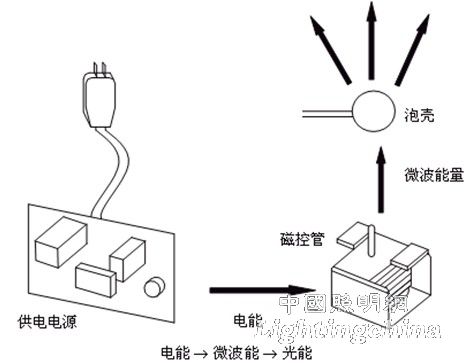I. Introduction
It is a long-term pursuit of human beings to find a light source with long life and high luminous efficiency. This has become more urgent in the early days of the energy crisis. Because there is no electrode, the electrodeless discharge source has many advantages compared with the conventional light source, such as long life, low light decay during the lifetime, and no concern about the interaction between the luminescent substance and the electrode. In addition, the electrodeless discharge source also has good performance in dimming. According to the current experimental situation, the dimming color table has a small change, the luminous efficiency is less reduced, and the life of the light source is not affected. However, in 1891, Tesla first discovered that plasma can generate light in high-frequency electromagnetic fields. It has been more than a century since the development of the electrodeless discharge source, and it has not been mature until the last two decades. The main reason for the development of the electrodeless discharge source is that it is difficult to develop a ballast with stable performance, reasonable size and reasonable price. Until the 1980s, with the gradual development of semiconductor electronics and switching power supply technology, the realization of the electrodeless discharge light source product became possible. At present, a variety of non-polar discharge light source products have been available, and related research is also deepening. The electrodeless discharge light source currently entering the commercialization stage is mainly concentrated on the electrodeless fluorescent lamp.
Second, the type of electrodeless discharge light source
Electrodeless discharge means that there is no built-in electrode in the discharge, so that the discharge chamber can be sealed with a single material. The electrodeless discharge was first discovered by Hittorf, and then Thomson made a more complete study. Tesla first designed the lighting concept lamp using the principle of electrodeless discharge. With the rapid advancement of semiconductor technology at the end of the last century, it has become possible to manufacture ballasts with reliable performance and low price. The research on electrodeless discharge sources has been carried out in depth. More than 2,000 patents for induction lamps have been approved in the past 20 years. It is available and shows great potential. The electrodeless discharge source can be either a high pressure discharge or a low pressure discharge. According to the current development, the electrodeless discharge source can have the following three types:
(1) Inductive discharge
Inductive discharges are sometimes referred to as H-type discharges, and the drive field is the azimuthal field, which causes the magnetic flux in the coil to change. An induction coil is wound inside or outside the discharge tube, and a discharge current is formed in the discharge tube by the principle of electromagnetic induction when the high-frequency current passes through the coil (as shown in FIG. 1). From an electrical point of view, the plasma is a single-turn secondary coil to the excitation coil, and the coil is connected to the power source to absorb the energy by appropriate impedance matching to maintain the discharge. Therefore, considering the energy transfer of the discharge can be approximated by a transformer model, the plasma generating a closed current can be regarded as the secondary coil of the transformer, and the primary coil can be placed in the middle of the plasma or placed around the plasma. Such discharges are referred to as "inductive coupling (ICD)", "induction lamps", "solenoid electric field (SEF)", and "no divergence field". The lamp thus discharged can be designed in many shapes, and the material of the core coil can be classified into two types: a built-in type and an external type. In such a discharge, as long as sufficient power is supplied to maintain the H-type discharge, it can obtain sufficient coupling efficiency at a relatively low frequency, and thus an ideal luminous efficiency can be obtained. At present, the inductive discharge can achieve a power range of 10-1000W and a discharge frequency between 50KHz-100MHz. It has also been found in practical research that such a design is relatively simple, and electromagnetic interference is relatively small, and a relatively low frequency can be used, so that the cost of electronic components of the ballast can be reduced.

Figure 1 Basic structure of induction discharge
(2) Capacitive discharge

Figure 2 Schematic diagram of a fluorescent lamp with capacitive discharge
Capacitive discharge is often referred to as an E-type discharge. Such a plasma can be thought of as a sealed glass container placed between the two plates of the capacitor. The E-type discharge is similar in principle to the ordinary electrode discharge, except that the two electrodes are moved outside the discharge tube (as shown in Figure 2). When the energy is coupled, it must pass through the sheath near the electrode. The discharge causes the characteristics of this discharge to be greatly affected by the drive frequency. Compared with the H-type discharge, the E-type discharge has a much lower coupling efficiency and a much lower power density. To get a high enough power density to meet the needs of the light source design, the ballast drive frequency is required to be very high, which causes the cost of electronic components to rise sharply. More notably, electromagnetic interference has also become serious, and related patents have reported using a drive frequency of 915 MHz to achieve capacitive discharge illumination. Due to its excellent discharge stability, capacitive discharge is used in indicator lighting such as aircraft dashboards.
(3) Microwave discharge
Under such discharge conditions, the wavelength of the electromagnetic wave and the size of the coupler and the discharge tube can be compared. In such a discharge, it is difficult to obtain sufficient energy to excite the atom because the electron with a high frequency does not collide with the surrounding particles. ) luminescence, so the elastic collision of electrons with surrounding particles in a microwave discharge is decisive. Electrons continuously change the direction of motion through elastic collisions, and gradually get enough energy from the microwave field to excite and ionize atoms (molecules). The characteristics of microwave discharge include the characteristics of E-type discharge and H-type discharge, but due to the higher microwave frequency, it has higher coupling efficiency and higher light efficiency. One of the main features of microwave discharge is the skin effect. When the driving frequency or power is increased, the skin depth is reduced. Therefore, the input power is concentrated near the tube wall. The highest temperature during discharge is not at the center of the arc, but close. The wall of the pipe. Such a temperature profile is beneficial for radiation and can facilitate the generation of resonant radiation (reduced self-absorption of gas cooling) and the generation of continuous molecular radiation (the temperature of the entire arc is not very hot). Since the magnetron generating microwave is a relatively mature product, the cost is slightly lower. However, due to the high microwave frequency, devices such as a waveguide and a coupling cavity are required, and the structure is complicated in design. FIG. 3 is a schematic diagram of the microwave discharge lamp. .

Figure 3 Schematic diagram of the operation of the microwave discharge lamp
Second, the development of electrodeless fluorescent lamps
The emergence of gas discharge light sources is a milestone breakthrough in the field of electric light sources, especially ordinary fluorescent lamps, which have now entered thousands of households to become daily needs. The gas discharge light source emits light by discharge between the electrodes, so the life of the electrode largely determines the life of the light source and limits the upper limit of the life of the light source. The discharge process is often accompanied by sputtering of the electrode material, causing the arc tube to black out and the luminous flux of the light source to decrease. These unfavorable factors prompted people to find new solutions. The most direct and daring idea was whether to invent a gas discharge source without electrodes. It is precisely because of this assumption that the first ç›Front fluorescent lamp was introduced in 1991, and a new era of gas discharge light source was opened.
In 1991, Matsushita Lighting Electric Co., Ltd. was the first to introduce the first electrodeless fluorescent lamp called Everlight. It is characterized by the fact that the coil is directly surrounded by the spherical bulb, which is different from the currently widely used energy coupling by means of the magnetic core. The disadvantage of adopting this method is that the magnetic leakage is large, and part of the energy is dissipated in the air, so that the luminous efficacy is limited. In addition, a wire mesh must be added to the blister to act as a Faraday cage to reduce electromagnetic interference. The occlusion effect of the coil and the wire mesh further limits the efficacy of the lamp. At that time, the 27W Everlight's Promise Fluorescent Light Effect was 37lm/W, with an average life of 40,000 hours and an operating frequency of 13.65MHz.
In the same year, Philips introduced QL electrodeless fluorescent lamps. It is characterized by a concave cavity in the pear-shaped bulb, which can be inserted into the ferromagnetic core column around the coil. Because the magnetic core is used, the energy coupling efficiency is greatly improved, and the light efficiency is greatly improved. The QL electrodeless fluorescent lamp has a luminous efficacy of 70 lm/W, an average life of 60,000 hours, and an operating frequency of 2.65 MHz. Another feature of this lamp is the use of a separate ballast structure. Since the lifetime of the electrodeless fluorescent lamp is generally longer than the life of its ballast, the separate structure provides the possibility of replacing the ballast, which extends the service life of the lamp to some extent.
In 1994, General Electric introduced the GENURA Promise Fluorescent Lamp. Its main structure is similar to the QL electrodeless fluorescent lamp, and it is also a ferromagnetic core column with a coil embedded in a pear-shaped bulb with a concave cavity. But the difference is that the compact structure of the lamp and the ballast is integrated, which is mainly intended to replace the incandescent lamp. Therefore, the GENURA electrodeless fluorescent lamp introduced at that time has a small power of 23W. It has a luminous efficacy of 48 lm/W, an average life of 15,000 hours, and an operating frequency of 2.65 MHz.
In 1997, OSRAM launched the ENDURA electrodeless fluorescent lamp. The utility model is characterized in that a tubular square discharge tube structure is adopted and a ferromagnetic core ring around which a coil is wound is arranged on both ends of the discharge tube. Due to the external magnetic ring structure, the heat dissipation problem can be conveniently solved, which is beneficial to achieve high power discharge. The ENDURA non-polar fluorescent lamp introduced at that time was 150W and the luminous efficiency was 80 lm/W. Its operating frequency is 250kHz, which reduces electromagnetic interference and reduces the cost and practical difficulty of the drive circuit.
Since then, in order to promote the application of the electrodeless fluorescent lamp, the low power to replace the incandescent lamp has become a hot spot for the development of the current electrodeless fluorescent lamp. Different companies have launched their own products, such as Panasonic's Pa-Look Ball YOU, Hongyuan's Venus series and Osram's Dura-One. At present, the development of China's Promise Fluorescent Lamps is relatively fast. There are already hundreds of manufacturers of Promise Fluorescent Lamps, and the application fields have been continuously expanded.